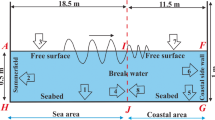Abstract
In this study examined is the wave interaction with a new modified perforated breakwater, consisting of a perforated front wall, a solid back wall and a wave absorbing chamber between them with a two-layer rock-filled core. The fluid domain is divided into three sub-domains according to the components of the breakwater. Then by means of the matched eigenfunction expansion method, an analytical solution is obtained to assess the hydrodynamic performance of the new structure. An approach based on a step approach method is introduced to solve the complex dispersion equations for water wave motions within two-layer porous media. Numerical results of the present model are compared with previous limiting cases. The effects of rock fill on the reflection coefficient and the horizontal wave force are discussed.
Similar content being viewed by others
References
Jarlan G.E. (1961). A perforated vertical wall breakwater. Dock Harb. Auth. 41(486): 394–398
Sollit, C.K., Cross, R.H.: Wave transmission through porous breakwaters. In: Proc. 13th Coast. Eng. Conf., Vancouver, pp. 1827–1846. ASCE, New York (1972)
Madsen P.A. (1983). Wave reflection from a vertical permeable wave absorber. Coast. Eng. 7: 381–396
Yu X.P. and Chwang A.T. (1994). Wave motion through porous structures. J. Eng. Mech. 120(5): 989–1008
Li, Y.C., Sun, L., Teng B.: Wave interaction with arrays of combined cylinders with a solid interior column and a porous exterior column (in Chinese). Acta Mech. Sin. 37(2), 141–147 (2005)
Huang Z.H. and Ghidaoui M.S. (2007). A model for the scattering of long waves by slotted breakwaters in the presence of currents. Acta Mech. Sin. 23(1): 1–9 DOI 10.1007/s10409-006-0044-3
Kondo, H.: Analysis of breakwaters having two porous walls. In: Proc. Coast. Struct. Conf., Alexandria, Virginia, pp. 962–977. ASCE, New York (1979)
Fugazza M. and Natale L. (1992). Hydraulic design of perforated breakwaters. J. Waterw. Port Coast. Ocean Eng. 118(1): 1–14
Li Y.C., Dong G.H., Liu H.J. and Sun D.P. (2003). The reflection of oblique incident waves by breakwaters with double-layered perforated wall. Coast. Eng. 50: 47–60 DOI 10.1016/j.coastaleng.2003.08.001
Huang Z.H. (2006). A method to study interactions between narrow-banded random waves and multi-chamber perforated structures. Acta Mech. Sin. 22(4): 285–292 DOI 10.1007/s10409-006-0021-x
Tanimoto, K., Yoshimoto, Y.: Theoretical and experimental study of reflection coefficient for wave dissipating caisson with a permeable front wall (in Japanese). Rep. Port Harb. Res. Int. 21(3), 44–77 (1982)
Li Y.C., Liu H.J., Teng B. and Sun D.P. (2002). Reflection of oblique incident waves by breakwaters with partially-perforated wall. China Ocean Eng. 16(3): 329–342
Isaacson M., Baldwin J., Allyn N. and Cowdell S. (2000). Wave interactions with perforated breakwater. J. Waterw. Port Coast. Ocean Eng. 126(5): 229–235
Yip T.L. and Chwang A.T. (2000). Perforated wall breakwater with internal horizontal plate. J. Eng. Mech. 126(5): 533–538
Teng B., Zhang X.T. and Ning D.Z. (2004). Interaction of oblique waves with infinite number of perforated caissons. Ocean Eng. 31: 615–632 DOI 10.1016/j.oceaneng.2003.08.001
Dalrymple R.A., Losada M.A. and Martin P.A. (1991). Reflection and transmission from porous structures under oblique wave attack. J. Fluid Mech. 224: 625–644
Losada I.J., Silva R. and Losada M.A. (1996). 3-D non-breaking regular wave interaction with submerged breakwaters. Coast. Eng. 28: 229–248
Chwang A.T. (1983). A porous-wavemaker theory. J. Fluid Mech. 132: 395–406
Yu X.P. (1995). Diffraction of water waves by porous breakwaters. J. Waterw. Port Coast. Ocean Eng. 121(6): 275–282
Taylor G.I. (1956). Fluid flow in regions bounded by porous surface. Proc. R. Soc. Lond. A 234: 456–475
McIver P. (1998). The dispersion relation and eigenfunction expansions for water waves in a porous structure. J. Eng. Math. 34: 319–334
Mendez F.J. and Losada I.J. (2004). A perturbation method to solve dispersion equations for water waves over dissipative media. Coast. Eng. 51: 81–89 DOI 10.1016/j.coastaleng.2003.12.007
Sahoo T., Lee M.M. and Chwang A.T. (2000). Trapping and generation of waves by vertical porous structures. J. Eng. Mech. 126(10): 1074–1082
Mallayachari V. and Sundar V. (1994). Reflection characteristics of permeable seawalls. Coast. Eng. 23: 135–150
Author information
Authors and Affiliations
Corresponding author
Additional information
The project supported by the Program for Changjiang Scholars and Innovative Research Teams in Universities (IRT0420). The English text was polished by Keren Wang.
Rights and permissions
About this article
Cite this article
Liu, Y., Li, Y. & Teng, B. Wave interaction with a new type perforated breakwater. Acta Mech Sin 23, 351–358 (2007). https://doi.org/10.1007/s10409-007-0086-1
Received:
Revised:
Accepted:
Published:
Issue Date:
DOI: https://doi.org/10.1007/s10409-007-0086-1



